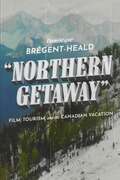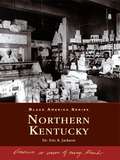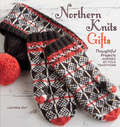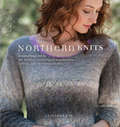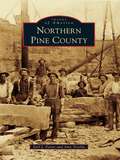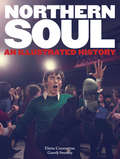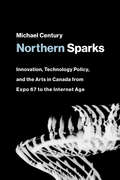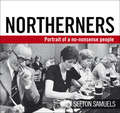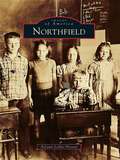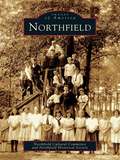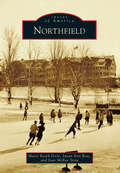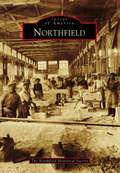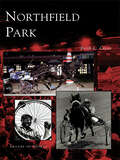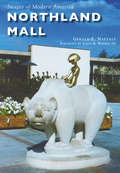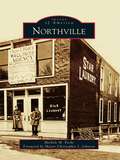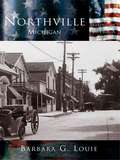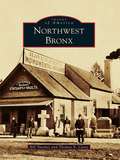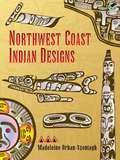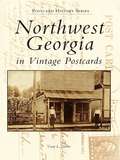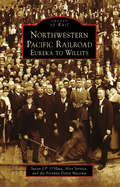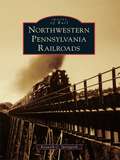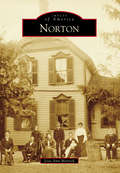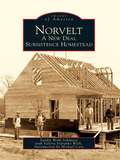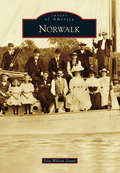- Table View
- List View
Northern Getaway: Film, Tourism, and the Canadian Vacation
by Dominique Brégent-HealdFor more than a century, posters, advertisements, and brochures have characterized Canada as a desirable tourist destination offering spectacular scenery, wild animals, outdoor recreation, and state-of-the-art accommodations. However, these explicitly commercial displays are not the only marketing tools at the country’s disposal; beginning in the 1890s, film also played a role in selling Canada.In Northern Getaway Dominique Brégent-Heald investigates the connections between film and tourism during the first half of the twentieth century, exploring the economic, pedagogical, geopolitical, and socio-cultural contexts and aspirations of tourism films. From the first moving images of the 1890s through the end of the 1950s, a complex web of public and private stakeholders in Canadian tourism experimented, sometimes in collaboration with Hollywood, with a variety of film forms – 16 mm or 35 mm, feature or short films, fiction or nonfiction, professional or amateur filmmakers – to promote Canada. Spectators, particularly Americans, saw Canada as a tourist destination on screens in motion picture theatres, schools, and fairgrounds. Rooted in settler colonial representations that celebrate the nation’s unspoiled but welcoming wilderness landscapes, these films also characterize Canada as a technologically and industrially advanced settler country.Using evidence from a wide range of archival sources and drawing from current scholarship in film history and tourism studies, Northern Getaway demonstrates how Canada was an innovator in using film to shape and project a recognizable destination brand.
Northern Kentucky (Black America Series)
by Dr Eric JacksonAlong the picturesque southern banks of the Ohio River, the African-American communities of Boone, Campbell, and Kenton Counties have provided laborers and entrepreneurs to aid in the economic growth of the region from the earliest settlements to today. Despite numerous obstacles and against seemingly insurmountable odds, African Americans in Northern Kentucky made significant contributions in many fields, ranging from music, medicine, and literature to performing arts, poetry, education, and athletics.
Northern Knits Gifts: Thoughtful Projects Inspired by Folk Traditions
by Lucinda GuyIn Northern Knits Gifts, knitwear and textile designer Lucinda Guy continues her exploration of folk-knitting traditions in this colorful volume of small projects and accessories. You'll learn some of the traditional knitting techniques of Scandinavia, Estonia, Iceland, and the Faroe and Shetland islands, through modern interpretations of such heritage techniques as twined knitting, two-color knitting, lace techniques, damask, fair isle, embroidery, and rya (knotted knitting similar to shag carpet).Northern Knits Gifts embraces the Danish notion of hygge - taking pleasure in comforting and cozy things, which is often associated with family and close friends. The 20 projects include mittens, socks, hats, scarves, and bags, and are perfect for wearing and gifting. Emphasizing pattern and color, these knitted designs also embody the Scandinavian aesthetic of making utilitarian objects beautiful as well as useful.Additionally, the book celebrates the specific wools traditionally used in each project. Immerse yourself in Lucinda's world as you enjoy thumbnail sketches of the history and folk culture surrounding each technique.
Northern Knits: Designs Inspired by the Knitting Traditions of Scandinavia, Iceland, and the She tland Isles
by Lucinda GuyInspired by folk traditions and the wholesome purity of natural wool yarns, this collection of 20 stunning patterns for both traditional and contemporary women's garments and accessories is perfect for the modern knitter. The traditions of the quintessential knitting cultures of Iceland, Shetland, Norway, and Sweden are examined, from descriptions of the wools and yarns to the history of the clothing traditionally made from them, including breathtaking photomontages of these classic vintage styles. Exploring a range of techniques and knitwear construction, the projects in this guide feature knitting in the round, steeking, lace, cables, Fair Isle, twined knitting, and embroidery and show how to create pieces such as cardigans, sweaters, blouses, scarves, and hats.
Northern Pine County
by Earl J. Foster Amy TroolinFeaturing over 210 historical photographs, Images of America: Northern Pine County guides readers on an exciting journey into the past as it explores the successes and sorrows as well as the joys and trials of the people of northern Pine County, Minnesota. Each chapter examines a unique aspect of their daily lives. Readers meet loggers and settlers from the county's earliest days, catch a glimpse of many towns and villages, and encounter a variety of industries, businesses, schools, and churches that shaped the area's economic and social landscapes. Life was not easy for the people who called northern Pine County home. On September 1, 1894, and again on October 12, 1918, forest fires devastated portions of the county, killing hundreds, destroying thousands of acres, and leaving countless residents homeless. While photographs cannot capture the heartache of fire victims, they do provide a window into northern Pine County's rich history and help tell the fascinating stories of its residents.
Northern Soul: An Illustrated History
by Elaine Constantine Gareth SweeneyThe story of Northern Soul is one of practically total immersion, dedication and devotion, where the plain concept of the ‘night out’ was elevated to sacramental dimensions. Where devotees pushed their bodies, their finances and sometimes their minds to brutal and unforgiving extremes. For those who went through that involvement every test of faith or endurance was worth bearing.- From Northern Soul: An Illustrated History.‘It was a drugs scene, it was a clothes scene. It was about dancing. It came out of this thing. It was about pills that made you go fast. To go fast to make the scene happen.’ - Chris BrickIn the late 1960s, a form of dance music took a feverish hold on the UK, finding its heart in the north of England. The music of 1960s-70s black American soul singers combined with distinctive dance styles and plenty of amphetamines to create what became known as Northern Soul – a scene based around all night, alcohol-free club nights, arranged by the fans themselves – setting the blueprint for future club culture. Northern Soul tapped into a yearning for individual expression in northern teenagers, and exploded into a cultural phenomenon that influenced a generation of DJs, songwriters and designers for decades to come. Acclaimed photographer and director Elaine Constantine has brought the movement to life in her film Northern Soul – and that film was the starting point for this book, Northern Soul: An Illustrated History.However, what started out as a project largely comprising of Constantine’s stunning on-set photography, featuring her young, talented cast and highly authentic production, has turned into a unique illustrated history of Northern Soul. In its final form, the beautiful new photography holds the book together thematically, but its real depth lies in the material from the 1960s, 1970s and 1980s that Elaine and Gareth have researched and pulled together. Of course, no book can claim to represent everything about a culture. But Northern Soul: An Illustrated History concentrates on individuals’ personal stories from that heady era, as well as being crammed full of truly atmospheric contemporaneous photography – not from press photographers, but from the kids themselves. Be it snaps of soul fans in car parks, hitching a lift or mucking around in photo booths, the combination of real people plus real (and often very dramatic) stories – not to mention the complete absence of label scans and DJ’s top tens – means that the book stands out as a very different proposition from anything yet published on Northern Soul. We would like to think that above all, this book attempts to give you a feel for what it was really like to be there at the time.
Northern Sparks: Innovation, Technology Policy, and the Arts in Canada from Expo 67 to the Intern et Age (Leonardo)
by Michael CenturyAn &“episode of light&” in Canada sparked by Expo 67 when new art forms, innovative technologies, and novel institutional and policy frameworks emerged together.Understanding how experimental art catalyzes technological innovation is often prized yet typically reduced to the magic formula of &“creativity.&” In Northern Sparks, Michael Century emphasizes the role of policy and institutions by showing how novel art forms and media technologies in Canada emerged during a period of political and social reinvention, starting in the 1960s with the energies unleashed by Expo 67. Debunking conventional wisdom, Century reclaims innovation from both its present-day devotees and detractors by revealing how experimental artists critically challenge as well as discover and extend the capacities of new technologies.Century offers a series of detailed cross-media case studies that illustrate the cross-fertilization of art, technology, and policy. These cases span animation, music, sound art and acoustic ecology, cybernetic cinema, interactive installation art, virtual reality, telecommunications art, software applications, and the emergent metadiscipline of human-computer interaction. They include Norman McLaren&’s &“proto-computational&” film animations; projects in which the computer itself became an agent, as in computer-aided musical composition and choreography; an ill-fated government foray into interactive networking, the videotext system Telidon; and the beginnings of virtual reality at the Banff Centre. Century shows how Canadian artists approached new media technologies as malleable creative materials, while Canada undertook a political reinvention alongside its centennial celebrations. Northern Sparks offers a uniquely nuanced account of innovation in art and technology illuminated by critical policy analysis.
Northerners
by Sefton SamuelsThe word 'northern' conjures plenty of stereotypical images; men in flat caps, cobbled streets, pies and rain. But beyond the clichés lies a region rich in its diversity, devilish in its humour and fertile in its culture, and it is these characteristics that iconic photographer Sefton Samuels has captured faithfully over four decades, and are compiled here in Northerners.Described by the Guardian as 'the photographic equivalent of Ken Loach', Samuels shot legendary figures of northern life, from Alan Bennett to Morrissey, LS Lowry to George Best and Sir Ben Kingsley, but most famously and vividly he captured the realities of everyday life across the north. With snatched shots of children cheekily mugging to his camera, pictures of the more grandiose members of society at the local hunt, photos of the bleaker side of life with the riots in Moss Side, and snaps of the young and fashionable posing as they hang around with nothing to do, Northerners reveals a photographer at one with his subject; and a region whose open character was meant to be captured through a lens.
Northfield
by Arlynn Leiber PresserIn 1926, railroad and electric power tycoon Samuel Insull held a contest to name a station on the Skokie Valley Electric Line that the locals already called the Skokie Swamp. The winning name? Wau Bun, a Potawatomi word meaning "dawn" and also the name of a noted Potawatomi chief from the late 1700s. But the residents of Skokie Swamp hated the name and plotted their revenge. Three years later, as Insull was on a train pulling into the station, he was horrified to discover that vandals had taken it upon themselves to rename the station Hot Bun. Insull and the locals compromised, and the more neutral moniker of Northfield was adopted. The Skokie Valley Electric Line has long since been closed, and popular legend holds that Insull died penniless and alone in Paris. But the town of Northfield has survived and thrived. Once a loose affiliation of farms, Northfield is now a quiet suburb that has enviable schools, beautiful homes, and gorgeous landscapes.
Northfield
by Northfield Historical Society Northfield Cultural CommitteeNorthfield is a vibrant South Jersey community with farm, seaport, and shipbuilding beginnings. First settled in the late 1700s, it is a place of beautiful homes built by ship captains during the 1700s and 1800s. Northfield portrays the history of the community with stunning photographs and a wealth of fascinating detail. At one time, Northfield grew food for Atlantic City hotels; its office for marriage license applications was in the insane asylum; and its glass factory sold laboratory glassware to Jonas Salk, discoverer of the polio vaccine.
Northfield (Images of America)
by Marie Booth Ferré Joan Mcrae Stoia Susan Post RossNorthfield's mountains, abundant forests, and rich agricultural fields along the Connecticut River sustained native inhabitants for centuries before the English settled in the area known as Squakheag in 1713. Incorporated in 1723, Northfield became a crossroads for travel and commerce, supporting ferries, taverns, mills, and other farm-related businesses. Elegant Federal-style homes crafted in the 1800s by the Stearns brothers still line the iconic Main Street. Northfield native Dwight L. Moody, a famous evangelist, founded area schools and summer conferences. In the late 19th century, the quiet farming town became "heaven on earth" to Moody's followers, who arrived by the hundreds each summer seeking spiritual renewal and relief from the cities. The railroad brought visitors to the first American youth hostel and to the popular Northfield Inn and Chateau, where many permanent residents found employment. Around Northfield, Queen Anne-style homes provided lodging for boarders, while tearooms, milliners, liveries, and grocers served visitors. Today, Northfield's vitality and spirit endures, forged by education, hard work, civic engagement, and perseverance.
Northfield (Images of America)
by The Northfield Historical SocietyChartered in 1781, Northfield is nestled in the foothills of the Green Mountains, with highlands to the east and west and the Dog River running through the center of town. It was once home to primarily farms, sawmills, and gristmills. With Elijah Paine building the first mills on Mill Hill, Northfield grew into a town comprising four villages. The community began to thrive with the coming of the railroad in the mid-1800s. Large granite sheds brought stonecutters and artisans from Italy, Spain, and Scotland. With woolen mills and a slate industry, Northfield changed from a largely agricultural town to an industrial one. In 1866, it became home to Norwich University. A vital part of the community, Norwich offers a wide variety of athletic and cultural events. Northfield captures the history of a community that still celebrates its heritage today.
Northfield Park (Images of Sports)
by Keith L. GisserFrom Al Capone and dog racing, to midget car and harness racing, the history of Northfield Park is one of the most colorful in the standardbred sport. A half-mile track located mid-way between Cleveland and Akron, Ohio, it has hosted the greatest drivers and horses in harness racing since its founding in 1957. From modest beginnings, the track now races 220 live race cards every year, providing a consistent racing schedule for patrons on-site and across North America via simulcast. This book details in both words and pictures the history of the storied oval known as The Flying Turns.
Northland Mall (Images of Modern America)
by Gerald E. Naftaly James B. Webber IIIWhen the Northland Mall opened in Michigan on March 22, 1954, it was the world's largest shopping center. Its innovative design was the vision of architect Victor Gruen and the Webbers, nephews of Joseph Lowthian Hudson and executives of the J.L. Hudson Company. Northland featured Hudson's flagship suburban store surrounded by other businesses selling a variety of merchandise and services. More than just a shopping destination, Northland Mall was a total experience of activity and relaxation, with colorful courtyards displaying sculptures such as the famous The Boy and Bear.
Northville
by Mayor Chris Johnson Michele M. FechtMost of the first pioneers came from New York by steamship across Lake Erie, disembarking in Detroit in the 1820s. From Detroit, it would take three days of treacherous travel through dense forests, thick brush, and swampy countryside to reach their destination--a hilly region in the northwest corner of Plymouth Township that would come to be called Northville. In the nearly 200 years since the first pioneers cleared the land and established their homesteads, Northville has distinguished itself as one of southeast Michigan's most desirable communities. Its rich historical heritage and small-town charm are evident in the stately Victorian architecture of the city's vibrant downtown and tree-lined neighborhoods. Surrounded by the rolling hills of adjoining Northville Township, the community has been shaped by generations of stakeholders committed to creating and maintaining Northville's picturesque and prosperous identity. Throughout its storied history, Northville has been home to the world's largest manufacturer of school furniture, the site of aviation pioneer Eddie Stinson's aircraft company, and the location for one of automotive legend Henry Ford's first village industries, the Northville Valve Plant.
Northville, Michigan
by Barbara G. LouieLocated only a short distance from the cacophony and activity of Detroit's metro area, Northville has maintained its unique small-town charm and identity across the passing decades. Even before the town's official incorporation in 1955, Northville's citizens worked tirelessly to preserve their picturesque setting in rural western Wayne County, to maintain the elegant Victorian architecture in their homes and businesses, and to carve out a prosperous community, marked by excellent schools and a high quality of life. Northville, Michigan brings to life, through word and image, the different events and eras that shaped this small town's history and recalls the area's notable personalities and influences, such as auto industry legend Henry Ford, aviation pioneer Eddie Stinson, and Wayne County Road Commissioner Edward Hines, and their impact on the general character of the community. Most importantly, this volume highlights the everyday person's existence in the Northville of yesteryear, providing today's readers a rare opportunity to glimpse into the lives and worlds of their ancestors and to experience firsthand how they worked, how they worshiped, and how they played.
Northwest Bronx (Images of America)
by Bill Twomey Thomas X. CaseyNorthwest Bronx is home to Wave Hill, Van Cortlandt Park, Woodlawn Cemetery, the New York Botanical Garden, and a variety of colleges and universities. Hunter College served as a training facility during World War II, and Mark Twain, Theodore Roosevelt's family, and Arturo Toscanini once lived at Wave Hill. Pres. John F. Kennedy's boyhood home is only steps from Wave Hill, and George Washington slept at the Van Cortlandt Mansion. Northwest Bronx features an array of vintage photographs of the borough's neighborhoods, from Spuyten Duyvil, Kingsbridge, Riverdale, and Woodlawn to the neighborhoods north of Fordham Road and west of the Bronx River.
Northwest Coast Indian Art: An Analysis of Form (Native Art of The Pacific Northwest: A Bill Holm Center Series)
by Bill Holm Burke Burke MuseumThe 50th anniversary edition of this classic work on the art of Northwest Coast Indians now offers color illustrations for a new generation of readers along with reflections from contemporary Northwest Coast artists about the impact of this book. <p><p>The masterworks of Northwest Coast Native artists are admired today as among the great achievements of the world's artists. The painted and carved wooden screens, chests and boxes, rattles, crest hats, and other artworks display the complex and sophisticated northern Northwest Coast style of art that is the visual language used to illustrate inherited crests and tell family stories.
Northwest Coast Indian Designs
by Madeleine Orban-SzontaghIn this volume, noted illustrator Madeleine Orban-Szontagh renders designs produced by the Indians of the Pacific Northwest, Alaska, and the western coast of Canada: Nootka, Kwakiutl, Tlingit, Haida, Tsimshian, and other groups. More than 270 original designs include stylized plants, birds and animals, abstract borders and repeating patterns, totemic images and symbols, and a host of other decorative elements. These arresting and beautiful Native American images lend themselves to use in a wide range of Indian-related graphic art and craft projects, as well as providing a rich source of design inspiration.
Northwest Georgia in Vintage Postcards
by Gary L. DosterFrom the 1890s through the 1920s, the postcard was an extraordinarily popular means of communication, and many of the postcards produced during this "golden age" can today be considered works of art. Postcard photographers traveled the length and breadth of the nation snapping photographs of busy street scenes, documenting local landmarks, and assembling crowds of local children only too happy to pose for a picture. These images, printed as postcards and sold in general stores across the country, survive as telling reminders of an important era in America's history. This fascinating new history of Northwest Georgia showcases more than two hundred of the best vintage postcards available.
Northwestern Pacific Railroad: Eureka to Willits
by Fortuna Depot Museum Susan J. O'Hara Alex ServiceThe year 2014 marks the centennial of the completion of the Northwestern Pacific Railroad (NWP), celebrated by driving a "golden spike" at Cain Rock in October 1914. This achievement was the culmination of a massive, six-year engineering effort to connect rail lines ending at Willits with the early lumber company railroads of the Humboldt Bay region. When it was completed, the NWP linked Eureka with San Francisco by rail, a milestone in the history of Humboldt and Northern Mendocino Counties. This book examines the impact of the NWP on Northwestern California. Although no longer operational, the railroad today symbolizes the ongoing struggle to connect this isolated region with the wider world.
Northwestern Pennsylvania Railroads
by Kenneth C. SpringirthErie's rail link to Philadelphia was achieved in 1864 with the completion of the Philadelphia and Erie Railroad, which later became part of the Pennsylvania Railroad. By 1869, railroad lines from Buffalo through Erie to Chicago were consolidated into the Lake Shore and Michigan Southern Railway, which later became part of the New York Central Railroad. Completed in 500 days, the parallel New York, Chicago and St. Louis Railroad, commonly known as the "Nickel Plate Road," was a 513-mile, well-designed railroad that emphasized excellent service. South of the lakeshore, the wide-gauge Erie Railroad enhanced east to west connections. Through vintage photographs, Northwestern Pennsylvania Railroads brings to life the history of the railroads that have served the region.
Norton
by Lisa Ann MerrickNorton Township was named for proprietor and principal landowner Birdsey Norton, a wealthy merchant from Goshen, Connecticut. However, he never set foot in Norton--he died six years before the township was organized in 1818. Early settlers, the first of whom were James Robinson and John Cahow, carved their way through the wilderness to build on this fertile land. In its early form, Norton included seven small hamlets: Loyal Oak, Western Star, Sherman, Johnson's Corners, Norton Center, Hametown, and New Portage. Each hamlet had its own unique shops, taverns, blacksmiths, and mills. These communities were home to familiar local names like Seiberling, VanHyning, Harris, Miller, Oplinger, and Breitenstine. By 1961, Norton had become recognized as a village, and by 1968 its growth warranted the designation of city. Early businesses, local schools and churches, aerial views, accidents, and intrigue can all be found within the pages of Images of America: Norton.
Norvelt: A New Deal Subsistence Homestead
by Sandra Wolk Schimizzi Michael Cary Valeria Sofranko WolkIn 1933, the town of Norvelt became the fourth of 99 planned subsistence homestead communities subsidized by the federal government as part of the National Industrial Recovery Act for dislocated miners and industrial workers. The American Field Service Committee was recruited to implement and build the subsistence project and established a work camp in the summer of 1934. More than 1,850 people applied for 250 lots, and the first 1,200 homesteaders helped build their own homes on a lease-to-purchase agreement. Homes were equipped with a grape arbor, 3.4 acres of land, and chicken coops. Cooperatively, homesteaders established community garden plots and raised livestock, hogs, and chickens. A format of cultural, political, and religious expression was provided to the residents, and through vintage photographs Norvelt: A New Deal Subsistence Homestead celebrates the remarkable life transformation the homesteaders were able to experience during the town's formative years.
Norwalk (Images of America)
by Lisa Wilson GrantLocated on the shores of Long Island Sound, Norwalk's close proximity to New York City prompted the building of many summer residences and guest cottages along its coast. In the summer, steamships and trolleys arrived with passengers looking to enjoy the local amusement park, Roton Point. Norwalk's earliest industries included farming as well as mills powered by its rivers. The area has been famous for its pottery, oystering, and hat manufacturing. Over time, this community has endured disasters; it was burned during the American Revolution, and the flood of 1955 wiped out much of the Wall Street area as well as several bridges on the Norwalk River. Norwalk shares vintage images from the mid-1800s through the 1960s, highlighting memorable sites such as Old MacDonald's Farm and the Melton Automobile Museum. The revitalization of Norwalk's downtown areas proves it is possible to respect the past and those that came before through the renewal of historical architecture.
